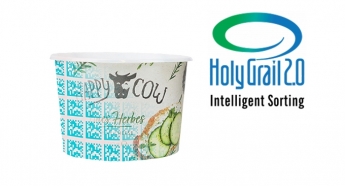Digital watermarking has huge potential to increase the plastic packaging recycling percentages and further close the materials loop. The principle is very simple. Each item of packaging is given a digital recycling passport containing full details of the origin, composition, materials and content of the packaging. This is an invisible code, the size of a postage stamp, printed on the packaging.
In the sorting centre, the watermark on the packaging is detected by a high-resolution camera on the sorting line. The packaging can then be automatically allocated to the correct flow. This not only reduces the margin of error in existing flows, but also makes it possible to sort more precisely and tap into additional recycling flows.
Furthermore, packaging from food and non-food products can be separated from one another, something which is not possible with systems that operate purely on the type of material. This distinction is crucial for meeting the food safety standards of recycled materials. Digital watermarks therefore have the potential to provide an answer to the increasing demand for recyclate for various applications.
HolyGrail 2.0 is examining the technical and economic feasibility of applying these systems on a large scale. The project began in 2018 and after a pilot phase and a semi-industrial test phase, has now reached an advanced stage. So during the course of 2022, various producers will be able to provide their packaging with digital watermarks that can be read in sorting facilities in Denmark, Germany and France.
Fost Plus is part of the consortium of partners. The HolyGrail 2.0 project provides Fost Plus with insights into the sorting and recycling of the future.
For more information about HolyGrail 2.0, go to www.digitalwatermarks.eu.

